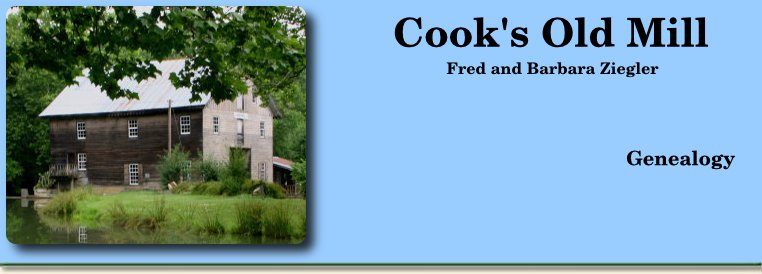Introduction to Cook Family Genealogy
All genealogy pages:
Three generations of Cooks built, ran and rebuilt Cook's mill starting with Valentine, then son Jacob, and finally grandson Riley B. Cook. The table, Cook Family Dates, provides essential details of the lives of all the Cooks that lived in the Indian Creek settlement area from their arrival in 1773 to their departure in 1877. Information is included on birthdates, parents, marriage partners, whether they lived a full life here or moved (their "fate"), and profession where known. Dates are included as well as a code for references to the information sources. The reference codes include a letter, from A for original records to D for unpublished materials, to signify the level of reliability of the respective sources.
The table contains basic information of interest to Cook family descendants, but it was constructed to provide an historical framework for understanding the chronology of events surrounding the mill. It also shows some interesting patterns in the early settlement of our area. The Cook families tended to be large but most of the children moved west, the first generation to Kentucky, the second to Indiana, and finally everyone packed up and left for Kansas, in parallel with the settlement pattern in the Midwest as a whole. In general one family remained in the Indian Creek Valley to run the mill, farm the land and raise the next generation for the migration west. There seems to be just one exception to this pattern and this is not shown on the table. A daughter of John H. Cook, Isabelle Margaret, did return to the valley and married Samuel C. Humphreys, and one of their descendents still lives on land originally settled by Valentine Cook.
Also included here are the wills of Valentine and Jacob which have been transcribed from the originals in the Monroe County Courthouse. And chronologies of the lives of Valentine, Jacob and Riley have been reconstructed using information from the basic table as well as other information gleaned from old records that hopefully will give some perspective to their lives. The following chronologies showing "The Life of" the mill owners are first attempts at drawing together relevant information, but much is left to be revealed about these early mill owners as reviewed in the following paragraphs.
Valentine Cook's early history, including his birth date, and the birth dates and birth places of his children are very uncertain. The biography of Valentine, Jr. provides some good information but this was published in 1858, long after both had died. On-line sources collectively provide a variety of possible dates for each birthday, and a guess was made as to the most likely one for our purposes. Also, we have no indication of when the original mill was built, only that it existed when Valentine died in 1797. Before moving here he may have had a mill on Hawksbill Creek which was a tributary of the southern branch of the Shenandoah or he may have had some prior history as a miller.
Valentine's son, Jacob Cook's life is fairly well accounted for in the chronology provided here. He seems not to have occupied his time in the mill itself, but rather as an itinerant Methodist preacher attending to a circuit of churches in the area. Whether he did this his whole career is uncertain-a number of documents attach the word "Reverend" to his name. He did not marry until his early thirties so perhaps his main preaching activities were as a young man. Then he brought up two families and eventually died in debt-the mill could not have been much of a money maker!
In the third generation, Riley Cook's life is pretty well accounted for in the courthouse records. The question that remains about his life is the nature of the lawsuit that he and others were involved in during the 1870's and 80's. In 1868 he had sold ½ interest in the mill to Hinton, Barley & Company, a "mercantile firm". Barley later sued Riley and several of the partners for a total of $23,256.33 in Chancery Court, apparently over real estate dealings! By 1877, the Cook family home was sold at public auction and Riley moved his family to Kansas. The court records are sketchy, and require more study to probe this unfortunate case which went on for about 20 years, even after William Barley had died.
In conclusion, much remains to be done to reconstruct the lives of the Cooks of Indian Creek, and Centreville as it was known by 1846 (only in 1890 was the name changed to Greenville). Help in this enterprise is being contributed by several Cook descendants, but the hope is that others will come forward with family documents. Especially useful would be old letters, obituaries, inscriptions from family bibles, genealogies and possibly even photographs. The plan is to eventually incorporate all of this into a book on "Cook's Old Mill".
